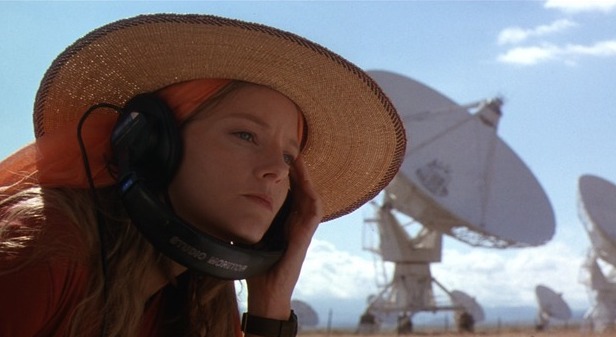
Thirteen years ago, there was a big-budget summer blockbuster that did something rare: it entertained people AND made them think about important philosophical issues. Its repercussions continue to be felt today. That movie, of course, was “Beverly Hills Ninja.”
No, I kid, it was “Contact,” starring Jodie Foster and Matthew McConaughey. This was 1997, when Jodie Foster still made movies regularly, and when the novelty of Matthew McConaughey hadn’t worn off yet. Robert Zemeckis, who had just won an Oscar for directing “Forrest Gump” — THAT IS A THING THAT REALLY HAPPENED — chose as his next project this story, based on a novel by Carl Sagan.
Sagan, who died eight months before the film was released, was next to Isaac Asimov and Stephen Hawking in the category of Super-Smart Guys Who Look at the Stars and Know Everything About Them. The stereotype would be that he was therefore an atheist, but Sagan always insisted he was agnostic. “An atheist has to know a lot more than I know,” he said. “An atheist is someone who knows there is no god. By some definitions atheism is very stupid.”
As a scientist, Sagan was interested in observable facts. Religious faith is more about intangibles. Yet science and faith are not mutually exclusive, despite what you may have heard from Richard Dawkins or Conservapedia. “Contact” acknowledges that sometimes even science requires a leap of faith. Sometimes you can know something without being able to prove it.
Zemeckis says in the DVD commentary that he meant for the film to portray science and religion as being compatible. But he doesn’t convey this as well as he thinks he does. Nearly all of the scientists in the movie are good people. The only exception is Drumlin (Tom Skerritt), who’s a soulless capitalist bureaucrat (“There’s no reason science shouldn’t be profitable!”), rather than a noble seeker of truth.
Meanwhile, nearly every religious person in the film is a loon. (From here on there be spoilers.) A Christian suicide-bomber destroys the device that would transport an astronaut to wherever the aliens are. A slick religionist with a Southern accent urges caution in responding to the aliens’ messages because “we know nothing of these creatures’ values. We don’t even know if they believe in God!” Drumlin gets himself appointed for the space mission by pandering to the committee members who want the job to go to someone who believes in God. And then the suicide bomber blows it all up anyway. See? Those God people ruin everything.
The exception to all of this is the McConaughey character, Palmer Joss, who’s quick to mention that he opted out of the priesthood because he didn’t want to be celibate, then drives his point home by sleeping with Foster’s character, Ellie Arroway, on their first date. Palmer describes his religious conversion as a deeply spiritual experience — but at no point in the film does he actually talk or act like a religious person. He’s the Hollywood version of “religious,” which means he believes in God but doesn’t practice any particular faith, for fear of alienating viewers who don’t belong to that religion.
In Sagan’s novel, it’s a team of five people sent to meet the aliens, and there’s no suicide bomber. The movie wants to have things both ways. First Arroway is denied the opportunity to hang out with aliens because she doesn’t believe in God. The selection committee’s rationale is that since 95 percent of Earthlings believe in a Supreme Being in one form or another, it wouldn’t be logical to send an atheist — a statistical outlier — to represent us to the aliens. That makes perfect sense, if you agree that the astronaut should be someone who is “typical” of humankind. But if we’re going that route, you couldn’t choose an American, because most Earthlings are from Asia, and you’d definitely have to send a woman, because they outnumber men, and obviously anyone left-handed would be out of the question. But I digress.
Anyway, Drumlin is a weasel for pretending to believe in God just to beat Arroway for the job. We are sad for Arroway. Then the thing goes kabluey, Drumlin with it, and we feel vindicated. And hey, guess what! There was ANOTHER transport device that was SECRETLY being built — not by the government, which is prone to meddling by religious do-gooders, but by a private citizen, billionaire scientist S.R. Hadden (John Hurt)! Since it’s his own project, he can send whoever he wants, atheists included. He could send a gay communist atheist Eskimo if he wanted to. (Why didn’t he do this??? We will never know.)
The big twist is that when Arroway comes back from communing with aliens, there’s no proof of it. None of her recording devices worked, and while the trip felt like 18 hours to her, to observers it looked like the transport pod simply fell straight into the ocean, a journey of two seconds. Everyone assumes she hallucinated the whole thing.
Here the religious people in the audience can smile. The tables have been turned on Arroway. She has no proof of what happened and must ask everyone to take it on faith. She freely admits that as a scientist, she wouldn’t believe her story either. Nonetheless, she knows it’s true. She says of the experience, “I wish that everyone, if only for one moment, could feel that awe, that humility, that hope.” Many people who have had deep religious experiences say the same thing.
But wait, the movie isn’t done having it both ways just yet. Having suggested that there could be times when scientists must take a leap of faith, just as religious people do, the movie declares that the recorders picked up 18 hours of static — exactly the amount of time Arroway thought she was gone. We’ve gone from “not everything you know to be true can be proven” to “oh wait, here’s proof after all.” Never mind!
“Contact” isn’t a bad film, of course. It’s not even particularly brazen in its anti-religion sentiments. But neither is it as even-handed and balanced as it pretends to be. It pays lip service to fairness without actually committing to it — which, I admit, is more than a lot of movies do. And still, it’s not nearly as offensive as the blatant anti-God message of “Beverly Hills Ninja.”
— Cinematical




